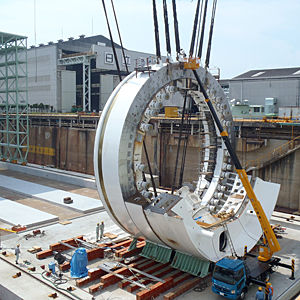
Contact Details:
EngNet - Engineering Network
11121 Carmel Commons Blvd.
Charlotte
NC
28226
United States of America
Tel: +01 704 5413311
Fax: +01 704 9430560
Send Enquiry | Company Information

Digging an Enormous Tunnel Under Downtown Seattle
Company News Monday, September 3, 2012: EngNet - Engineering Network
When you're about to carve a 57.4-foot-diameter tunnel under the Pacific Northwest's largest city, you do your homework. That's why the engineers at the Washington State Department of Transportation and its contractor, Seattle Tunnel Partners, rattle off the top of their heads facts about the monumental engineering project they're about to undertake.
Next spring crews will begin churning earth as they undertake a 1.7-mile-deep bore tunnel to replace a viaduct under downtown Seattle that is aging and vulnerable to earthquakes. The teams have drilled 600 test holes that show "very, very dense sands, silts, clays, and man-made fills in different consistencies" throughout the route, WSDOT engineer Dave Sowers says. Chris Dixon, Seattle Tunnel Partners project manager, says the tunnel's path will travel beneath 158 structures, eight of which will need extra precautions to make sure settling earth doesn't damage them. Such is the nature of drilling under downtown.
The Tunnel-Drilling Tool
To chip away—6-1/2 feet at a time—through the water and earth, Seattle Tunnel Partners hired Hitachi Zosen Corp., of Japan, to construct an $80 million tunnel-boring machine (TBM) with more than 700 cutting tools on its face.
The megamachine is currently under construction in Japan. Once finished and factory-tested, it will be disassembled into 40 pieces—with the largest component weighing 900 tons—and shipped to Terminal 46 at the Port of Seattle around the end of this year. That terminal sits across the street from the tunnel launch pit (the starting point), where workers will reassemble the TBM inside the pit. It will be the largest TBM ever used, even bigger than the monster machine at work in Miami.
Before settling on features, officials needed to know what type of earth they were dealing with. Tunnel-boring expert Greg Hauser says about one-third of the tunnel's length contains a mix of gummy clay and silt; the other two-thirds is abrasive sands and gravels. But the route also features some man-made fills created when a feature called Denny Hill was moved decades ago. It can prove wet, mucky, unstable, and full of debris. "Our goal when we picked this alignment is to get through the recent (fill) material quickly and get right into those hard, dense sands and clays," Sowers says. "While they are hard, it is better for tunneling than going through old timber trusses and soft materials."
To cut through it all, Dixon says, there are three main Seattle-specific components of the TBM: a free-air cutter-replacement system, a ribbon-type screw conveyor, and a smart cutter head.
The free-air cutter means that crews can fix the cutting tools from within the cutter head and at atmospheric pressure, alleviating the need for divers to work in highly pressurized conditions more than 200 feet below ground. The ribbon conveyor allows a larger diameter of debris to funnel out of the TBM—the machine can even digest 3-foot-diameter boulders. The 400-millimeter cutter head can independently push slightly ahead to accurately read ground pressure before deciding how to proceed, and whether crews want to sharpen the cutting tools before they proceed.
Extra Precautions
For many of the 158 buildings that stand above the tunnel's planned route, including downtown high-rises, even inches or fractions of an inch of settlement could spell trouble, especially for some already aging structures. Tony Stirbys, Seattle Tunnel Partners' geotechnical engineer, says the TBM minimizes settlement by applying pressure to the ground at all points.
At the face of the TBM, a mud mixture presses against the earth, and the machine uses a grout material around itself at all times to maintain even pressure on the tunnel walls. The TBM moves only 6-1/2 feet in a single push. Each time the machine moves, it takes 45 minutes to construct a circular segment ring that makes up the tunnel wall.
Basements—generally underground parking garages—could present a problem for the project because they drop as far as five stories underground (equivalent to up to 80 feet). But the tunnel's crown runs about 200 feet below the ground surface, so there's certainly some room to spare during the main stretch of tunnel.
"We plotted the settlement trough and looked to see which parts of which structures are predicted to settle to which amounts and predict if they will have an adverse effect on the structure," Dixon says.
Right now teams are working on buffeting those eight buildings identified as most endangered by the tunneling project. When a structure sits just slightly off the tunnel line, crews install what amounts to an underground micropile wall. By drilling a series of pipes into the ground at an angle and filling the pipes with grout or concrete, the wall will provide a barrier so that any ground movement stops at the wall and moves away from the building. When the tunnel runs directly beneath a building, engineers pump in grout or a similar mixture to reinforce soft soil, in essence creating a concrete-like wall below the building.
"The whole idea is to do something physical from a ground-treatment standpoint and isolate the adjacent building from experiencing any settlement due to ground movement," Dixon says.
The entire tunnel-boring process is supposed to take three years. It's a pressure-filled situation all around, both for those in the tunnel and those watching the settlement effects above ground. Everyone just hopes that construction crews aced their homework.
Source: http://www.popularmechanics.com/technology/engineering/extreme-machines/digging-the-worlds-widest-tunnel-under-downtown-seattle-12203389?click=pm_news
